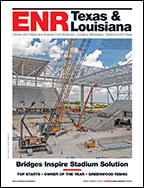Compounding that is a lack of construction sophistication. "The challenge is that they have limited relevant construction experience for projects of this size," says one of the members of TT's team, who also declines to be named for reasons of safety and security. "The level of sophistication is really low, so we are attempting to keep things as simple as we can, which is a challenge on a stadium with a tensile roof."
Even third-party inspections fall below the design team's comfort level. "They are not as rigorous or reliable as they are in the U.S.," says one project source.
Design-build delivery makes quality control even more difficult. All input from the design team about construction deficiencies goes to the contractor, rather than to the owner. "Where it goes from there, we don't know," says the architect. "It's a challenge to ensure that things we're citing get followed up on."
As a result, both the architect and the engineer are pressured to watch over construction more closely—though they are not contractually obligated to do so. The 360 Architecture team has full-time site representation. Still, "[we] spend a lot of time wondering if we've caught all the [field] deficiencies," says a TT engineer.
To try to make things easier, the design team is sharing its building information model with the contractor. Moreover, the engineer includes much more detail on the structural drawings. "We essentially give them shop drawings," says the TT engineer.
For example, exact bending details for the reinforcing steel in the cast-in-place concrete seating bowl are included, with cut lengths.
The design team also participates in procurement negotiations, the qualification of suppliers and scheduling. "In other projects, we would be hands-off," says the architect.
There are also challenges related to different cultures and customs. Typically, in Iraq, concrete block has no reinforcing steel. The design team was vigilant in making sure the block walls had rebar.
And Iraq's own technology infrastructure is absent, which complicated design. From a building infrastructure standpoint, the designers had to provide systems, such as for ticketing and concessions, that could operate in an archaic manner. But the team also has to provide a backbone for updated maintenance and operations once Iraq develops its own modern infrastructure. "For these projects, we've had to be cognizant that the local environment will transition over the next five years," says the architect. "Our stadium will be set up for it, and hopefully the rest of Iraq will catch up."
Why did the design team take on all the headaches? "It's cool to help the Iraqis rebuild," says the TT engineer. In addition, in 2009, when work on the project's design competition started, design firms were hungry for work because of the recession, he adds.
The design team isn't the only entity faced with challenges. Anwar Soura has its own issues, especially concerning coordination of the many parties, including its own design team and the ministry's local representative, AMBS. One problem is that government regulations are a moving target—they keep changing throughout the project, says Tariq Momika, Anwar Soura's vice president and project manager.










Post a comment to this article
Report Abusive Comment